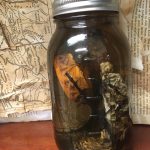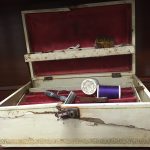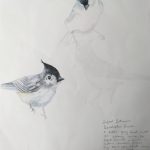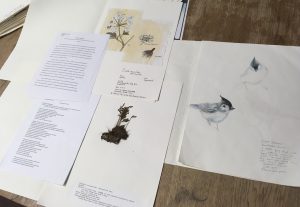Cabinet of Natural History
 The cabinet was a centerpiece of any great university. Cabinets featured “curiosities” from the natural world, exhibitions that served as sources of wonder. Before the natural sciences and humanities parted ways in the nineteenth century, resulting in an intellectual rift with us still today, the cabinet was a source of delight, combining of technical understanding with its own precise art.
The cabinet was a centerpiece of any great university. Cabinets featured “curiosities” from the natural world, exhibitions that served as sources of wonder. Before the natural sciences and humanities parted ways in the nineteenth century, resulting in an intellectual rift with us still today, the cabinet was a source of delight, combining of technical understanding with its own precise art.
The cabinet of curiosity in Harbor Hall, University of South Florida St. Petersburg, restores this forgotten practice. Through nature classes with Professor Thomas Hallock, students populate a literary cabinet of natural history: we venture into the field, catalog local flora and fauna, prepare specimens, and write. Neither a natural history in the technical sense nor a stale throwback, this cabinet seeks to revitalize a lost tradition for the present day.
 A mason jar preserves in rum “specimens” collected from nearby Salt Creek. Items retrieved from the creek include a fishing line and lure, discarded bottle cap, a mangrove leaf, a discarded condom, and of course, silt. The jar physically embodies the contents of a fragmented urban stream.
A mason jar preserves in rum “specimens” collected from nearby Salt Creek. Items retrieved from the creek include a fishing line and lure, discarded bottle cap, a mangrove leaf, a discarded condom, and of course, silt. The jar physically embodies the contents of a fragmented urban stream.
Other specimens reflect an ethos of care. Graduate student Hannah Gorski set out to retrieve the decaying carcass of a Great Blue Heron that was tangled in monofilament. Gorski loaded up her canoe with a bin, grabbers, and heavy gloves. But the rotting heron broke free in a storm. So Gorski retrieved a battered sewing box instead, occasioning a lyrical essay about Salt Creek.
Like the cabinet itself, the practice of incorporating natural history into a literature classroom has evolved slowly. Working with botanist Thomas Whitmore, students get the basics in plant collection. They gather specimens, press and prepare samples, research plants’ properties and “characters,” then use the exercise as a basis for literary-artistic reflection. Later in the semester, they do the same with birds, modeling their work after the old form of an Ornithological Biography.
The resulting essays vary with depth of research, extent of physical exploration, some degree of talent, and a willingness to engage in deep revision. While the assignment favors the nature-inclined, the process itself remains open to all. Students often surprise themselves. Grace Thompson, now a teacher in the Pinellas County school system, did not identify herself as a “Nature Writer” when she signed up for the class.
But hard work paid off. In her morning breakfast ritual at the Clearwater Mall Panera, Thompson noticed unusual bird activity, including the Tufted  Titmouse. Why did the mall parking lot draw such activity, Thompson wondered. During a meeting with me to discuss her paper, Thompson pulled up her favorite Panera on an online map; upon closer inspection, she observed how her breakfast spot sat between Lowe’s and Old Tampa Bay, still fringed with mangroves. This point led her back to John James Audubon, who was highly attentive to the interface between the human and natural world. An essay was born. Drawing from Audubon’s arch tone, Thompson would praise the Tufted Timouse’s “survivalist’s spirit,” noting that despite a “preference for woodland environment,” the titmouse can also “thrive in the unruly parking lots.”
Titmouse. Why did the mall parking lot draw such activity, Thompson wondered. During a meeting with me to discuss her paper, Thompson pulled up her favorite Panera on an online map; upon closer inspection, she observed how her breakfast spot sat between Lowe’s and Old Tampa Bay, still fringed with mangroves. This point led her back to John James Audubon, who was highly attentive to the interface between the human and natural world. An essay was born. Drawing from Audubon’s arch tone, Thompson would praise the Tufted Timouse’s “survivalist’s spirit,” noting that despite a “preference for woodland environment,” the titmouse can also “thrive in the unruly parking lots.”
Every bird, every plant contains a story, the editors of Sweden’s remarkable Herbaria 3.0 observe. The cabinet at USF St. Petersburg will continue to expand, as students explore now forgotten practices–drawing from underutilized, earlier literatures to clarify their own relationship with the natural world.

